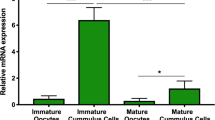Abstract
Previously it was shown that minK protein expression in uterus is regulated by estrogen. In the present study, we were interested in putative direct effects of estrogen on minK protein induced K+ currents (IminK) in Xenopus oocytes. Superfusion with 17-β-estradiol (1 μM) resulted in an inhibition of minK-induced currents, but had no appreciable effects on the delayed rectifier and inward rectifier K+ channels Kv1.1 and Kir2.1, respectively. The inhibition of IminK by 17-β-estradiol was concentration-dependent, with an IC50 of approximately 0.5 μM. In the presence of 17-β-estradiol, the conductance-voltage relationship was shifted to more depolarized potentials. IminK inhibition occurred also in the presence of the estrogen-receptor antagonist tamoxifen, suggesting that a mechanism independent of estrogen receptors is involved. The synthetic estrogen diethylstilbestrol (DES) also inhibited IminK but with a lower affinity (IC50 of 4.5 μM), while cortisol and progesterone had only weak effects on IminK. In summary, the results indicate that estrogens directly inhibit IminK.
Similar content being viewed by others
References
Attali B, Romey G, Honore E, Schmid-Alliana A, Mattei MG, Lesage F, Ricard P, Barhanin J, Lazdunski M (1992) Cloning, functional expression, and regulation of two K+ channels in human T lymphocytes. J Biol Chemistry 267:8650–8657
Binder K, Waldegger S, Nagl U, Paulmichl M, Franz HBG, Kiesel L, Herzer T, Gulbins E, Lang F, Busch AE (1996) Identification of the IsK protein in human uterus and regulation of its expression by estrogens. Pflügers Arch 431:R100
Boyle MB, MacLusky NJ, Naftolin F, Kaczmarek LK (1987) Hormonal regulation of K+ channel messenger RNA in rat myometrium during oestrus cycle and in pregnancy. Nature 330:373–375
Busch AE, Lang F (1993a) Effects of [Ca2+]i and temperature on minK channels expressed in Xenopus oocytes. FEBS Lett 334:221–224
Busch AE, Lang F (1993b) Time dependent changes in biophysical properties of minx channels expressed in Xenopus oocytes. Biochem Biophys Res Commun 197:473–477
Busch AE, Kavanaugh MP, Varnum MD, Adelman JP, North RA (1992) Regulation of the slowly activating, voltage-dependent potassium expressed in Xenopus oocytes. J Physiol (Lond) 450:491–502
Busch AE, Malloy K, Groh WJ, Vamum MD, Adelman JP, Maylie J (1994) The novel class III antiarrhythmics NE-10064 and NE-10133 inhibit minK channels expressed in Xenopus oocytes and IKs in guinea pig cardiac myocytes. Biochem Biophys Res Commun 202:265–270
Christie MJ, Adelman JP, Douglass J, North RA (1989) Expression of cloned rat potassium channels in Xenopus oocytes. Science 244:221–224
Fakler B, Brändle U, Glowatzki E, Zenner HP, Ruppersberg JP (1994) Kir 2.1 inward rectifier K+ channels are independently regulated by protein kinases and ATP-hydrolysis. Neuron 13: 1413–1420
Felipe A, Knittle TJ, Doyle KL, Snyders DJ, Tarnkun M (1994) Differential expression of minK mRNAs in mouse tissue during development and pregnancy. Am J Physiol 267:C700-C705
Folander K, Smith JS, Antavanage J, Bennett C, Stein RB, Swanson R (1990) Cloning and expression of the delayed-rectifier minK channel from neonatal rat heart and diethylstilbestrol-primed rat uterus. Proc Natl Acad Sci USA 87:2975–2979
Hadcock JR, Malbon CC (1991) Regulation of receptor expression by agonists: transcriptional and post-transcriptional controls. TINS 14:242–247
Murai T, Kakizuka A, Takumi T, Ohkubo H, Nakanishi S (1989) Molecular cloning and sequence analysis of human genomic DNA encoding a novel membrane protein which exhibits a slowly activating potassium channel activity. Biochem Biophys Res Commun 161:176–181
Paaby P, Nielson A, Raffin K (1989) A monthly cycle during third trimester pregnancy in the serum concentrations of progesterone and aldosterone and the urinary excretion rate of potassium. Acta Endocrinol 120:636–643
Parkington HC, Coleman HA (1988) Ionic mechanisms underlying action potentials in myometrium. Clin Exp Pharmacol Physiol 15:657–665
Pragnell M, Snay KJ, Trimmer JS, MacLusky NJ, Naftolin F, Kaczmarek LK, Boyle MB (1990) Estrogen induction of a small, putative K+ channel mRNA in rat uterus. Neuron 4:807–812
Raber G, Waldegger S, Herzer T, Gulbins E, Murer H, Busch AE, Lang F (1995) The nitroso-donor S-Nitroso-Cysteine (SNOC) regulates minK expressed in Xenopus oocytes via a c-GMP independent mechanism. Biochem Biophys Res Commun 207:195–201
Sudhir K, Chou TM, Mullen WL, Hausmann D, Collins P, Yock PG, Chatterjee K (1995) Mechanisms of estrogen-induced vasodilation: in vivo studies in canine coronary conductance and resistance arteries. J Am Coll Cardiol 26:807–814
Suessbrich H, Rizzo M, Waldegger S, Lang F, Lang HJ, Kunzelmann K, Ecke D, Bleich M, Greger R, Busch AE (1996) Inhibition of minK-channels — impact on the physiological role of minK-channels in cAMP-mediated cl− secretion of the colon. Biophys J 70:A30
Stühmer W, Stocker M, Sakmann B, Seeburg P, Baumann A, Grupe A, Pongs O (1988) Potassium channels expressed from rat brain cDNA have delayed rectifier properties. FEBS 242:199–206
Takumi T, Ohkubo H, Nakanishi S (1988) Cloning of a membrane protein that induces a slow voltage-gated potassium current. Science 242:1042–1045
Toro L, Stefani E, Erulkar S (1990) Hormonal regulation of potassium currents in single myometrial cells. Proc Natl Acad Sci USA 87:2892–2895
Tzounopoulos T, Guy HR, Durell S, Adelman JP, Maylie J (1995) minK channels form by assembly of at least 14 subunits. Proc Natl Acad Sci USA 92:9593–9597
Vamum MD, Busch AE, Bond CT, Maylie J, Adelman JP (1993) The minK channel underlies the cardiac potassium current IKs and mediates species-specific responses to protein kinase C. Proc Natl Acad Sci USA 90:11528–11532
Wang KW, Goldstein SAN (1995) Subunit composition of minK potassium channels. Neuron 14:1303–1309
Wangemann P, Liu J, Marcus DC (1995) Ion transport mechanisms responsible for K+ secretion and the transepithelial voltage across marginal cells of stria vascularis in vitro. Hearing Res 84:19–29
White RE, Darkow DJ, Lang JL (1995) Estrogen relaxes coronary arteries by opening BKCa channels through a cGMP-dependent mechanism. Circ Res 77:936–942
Yamamoto T (1995) Effects of estrogens on Ca2+ channels in myometrial cells isolated from pregnant rats. Am J Physiol 268:C64–9
Author information
Authors and Affiliations
Rights and permissions
About this article
Cite this article
Waldegger, S., Lang, U., Herzer, T. et al. Inhibition of minK protein induced K+ channels in Xenopus oocytes by estrogens. Naunyn-Schmiedeberg's Arch Pharmacol 354, 698–702 (1996). https://doi.org/10.1007/BF00166894
Received:
Accepted:
Issue Date:
DOI: https://doi.org/10.1007/BF00166894




